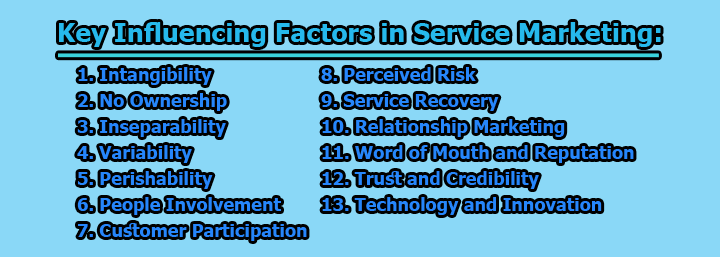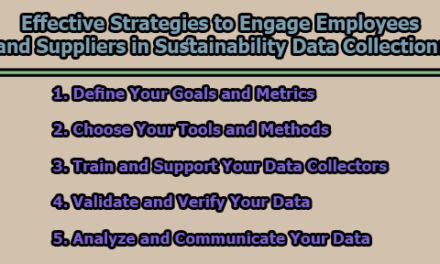Service Marketing:
In the ever-evolving landscape of business, service marketing has emerged as a pivotal concept that extends far beyond the traditional realm of product-centric marketing. It encompasses a wide array of industries, from healthcare and hospitality to banking and consulting. In this article, we will delve deep into the world of service marketing, exploring its meaning, importance, types, key influencing factors in service marketing, and providing real-world examples to illustrate its application.
Definitions of Service Marketing:
Let’s explore the definitions of service marketing from different writers’ perspectives to gain a well-rounded understanding of this concept:
1. Philip Kotler and Kevin Lane Keller:
Definition: “Service marketing involves the marketing of all economic activities whose output is not a physical product or a construction, is generally consumed at the time it is produced, and provides added value in forms (such as convenience, amusement, timeliness, comfort, or health) that are essentially intangible concerns of its first purchaser.”
Explanation: Philip Kotler, a prominent figure in marketing, and Kevin Lane Keller emphasize the intangible nature of services, their immediate consumption, and the added value they provide to customers. They highlight that services often address intangible needs and can be a source of convenience, amusement, and other intangible benefits.
2. Valarie Zeithaml, Mary Jo Bitner, and Dwayne Gremler:
Definition: “Services marketing is a subfield of marketing that can be divided into two main areas of study: services consumption and services management. Services marketing theory focuses on delivering processes and performance, in contrast to a physical product, which focuses on objects.”
Explanation: Zeithaml, Bitner, and Gremler emphasize the dual nature of services marketing, encompassing both the study of how customers consume services and the management of service processes. They highlight the distinction between services, which revolve around processes and performance, and physical products, which center on tangible objects.
3. Christopher Lovelock and Jochen Wirtz:
Definition: “Services marketing is a concept based on a recognition of the unique characteristics of services (intangibility, heterogeneity, inseparability of production and consumption, and perishability). Hence, services marketing differs from product marketing in several ways.”
Explanation: Lovelock and Wirtz underscore the significance of recognizing the unique characteristics of services, such as intangibility, variability, inseparability, and perishability. They emphasize that services marketing diverges from product marketing due to these distinctive features, which necessitate different strategies and approaches.
4. Booms and Bitner:
Definition: “Services marketing is a process of communicating the value of a service to customers, clients, or buyers with the intention of promoting or selling that service. Service marketing is the holistic marketing concept that is the integration of marketing concepts with service operations to ensure consistency with the service offering and the company’s overall positioning.”
Explanation: Booms and Bitner describe service marketing as a process of communicating the value of a service to customers, focusing on promotion and sales. They emphasize the integration of marketing concepts with service operations to ensure alignment with the company’s overall positioning and service offerings.
These various perspectives on service marketing provide a comprehensive view of the field, highlighting its unique characteristics, its role in delivering value to customers, and its integration with overall business strategies. Service marketing is a dynamic and evolving discipline that continues to adapt to the changing needs and preferences of customers in a service-oriented economy.
Importance of Service Marketing:
Service marketing, though challenging due to the intangible nature of services, is of paramount importance in today’s business landscape. It plays a crucial role in differentiating businesses, building relationships, ensuring customer retention, and ultimately achieving sustainable success. Let’s delve into why service marketing is so important:
1. A Key Differentiator: As markets become increasingly saturated and products more homogeneous, the quality of services provided has emerged as a key differentiator. Customers often choose between competitors not solely based on the core product but on the entire service experience that accompanies it. For instance, two pizza chains may offer similar pizzas, but it is the quality of service, including delivery speed, customer support, and overall experience, that sets them apart.
Marketing Strategy:
- Service Excellence: Companies can leverage service marketing to excel in customer service, ensuring that every customer touchpoint is exceptional.
- Brand Reputation: Reputation is built on the quality of service and customer experiences. Positive word-of-mouth and reviews can be powerful marketing tools.
2. Importance of Relationships: In service marketing, relationships are pivotal. Since customers cannot physically see or touch the service before purchase, trust in the service provider becomes paramount. Building and maintaining strong relationships with customers are integral to successful service marketing. A loyal customer base can drive repeat sales and act as brand advocates.
Marketing Strategy:
- Customer-Centric Approach: Service marketing focuses on understanding and meeting customer needs, nurturing trust and loyalty.
- Personalization: Tailoring services to individual customer preferences strengthens relationships and enhances satisfaction.
3. Customer Retention: Customer retention is a vital aspect of service marketing, particularly in today’s competitive landscape. Acquiring new customers can be costly, and retaining existing ones often proves more cost-effective. Services, which are typically produced and used simultaneously, provide an opportunity for continuous engagement with customers. By listening to customer feedback and adapting services to their evolving needs, businesses can enhance customer loyalty and reduce churn.
Marketing Strategy:
- Feedback Mechanisms: Implementing feedback systems and actively listening to customers can lead to service improvements and increased customer retention.
- Customization: Offering customization options based on customer preferences keeps customers satisfied and engaged.
Types of Service Marketing:
Service marketing is a multifaceted discipline that extends beyond conventional marketing strategies for tangible products. To gain a comprehensive understanding of service marketing, it is essential to explore the three key types: external service marketing, internal service marketing, and interactive service marketing. Each type plays a distinct role in promoting and delivering services effectively.
1. External Service Marketing: External service marketing is the outward-facing facet of service marketing. It focuses on promoting a company’s services to customers in settings external to the organization. This type of service marketing relies on conventional marketing techniques such as price, product, and promotion to attract and engage customers. Here are some key aspects of external service marketing:
a) Promotion to External Audiences: External service marketing is primarily concerned with reaching potential customers and conveying the value of the offered services. This is achieved through various channels, including advertising, social media, content marketing, and public relations.
b) Emphasis on Traditional Marketing Mix: External service marketing often employs the traditional marketing mix elements, known as the 4Ps: Product (the service offering), Price (the cost of the service), Place (where and how the service is available), and Promotion (marketing efforts to create awareness and interest).
c) Targeted Messaging: To effectively reach the intended audience, external service marketing tailors its messaging and communication strategies to address customer needs, preferences, and discomfort points.
2. Internal Service Marketing: Internal service marketing is an essential aspect of service marketing that focuses on promoting services within the company to its employees. It recognizes that employees are integral to the service delivery process and should be well-informed and motivated to effectively promote and deliver services. Key features of internal service marketing include:
a) Employee Engagement: Internal service marketing aims to engage and align employees with the company’s service goals and values. Employees who are enthusiastic about the services they provide are more likely to deliver exceptional customer experiences.
b) Knowledge Dissemination: Employees need to have a deep understanding of the services they offer. Internal service marketing involves training and communication efforts to ensure that employees are well-equipped to explain and promote the services.
c) Fostering a Service Culture: Companies that prioritize internal service marketing often cultivate a service-oriented culture where employees are encouraged to take ownership of customer satisfaction and actively contribute to service improvement.
3. Interactive Service Marketing: Interactive service marketing is the type of service marketing where service promotion and delivery occur through direct interactions between employees and customers. In this type, employees play a crucial role in conveying the value of the services and ensuring customer satisfaction. Here are some key components of interactive service marketing:
a) Employee-Customer Interaction: Interactive service marketing relies on the interactions between employees and customers to communicate the benefits of the service and address customer inquiries or concerns.
b) Personalization: This type of service marketing often involves tailoring service experiences to individual customer needs and preferences. Personalization enhances customer satisfaction and builds loyalty.
c) Service Quality Assurance: To excel in interactive service marketing, companies must maintain high service quality standards. Employee training, performance monitoring, and continuous improvement efforts are essential in this regard.
d) Customer Feedback: Feedback from customers plays a vital role in interactive service marketing. It helps companies identify areas for improvement and make necessary adjustments to enhance the overall service experience.
Applying the Three Types: The Case of Taj Hotels
To illustrate how these three types of service marketing can be applied, let’s consider the example of Taj Hotels, a renowned hotel chain:
- External Service Marketing: Taj Hotels will create advertisements, brochures, and digital marketing campaigns to showcase its wide range of services to potential customers. They will highlight luxurious accommodations, dining options, and unique amenities to entice travelers.
- Internal Service Marketing: Within the organization, Taj Hotels will conduct training programs and orientation sessions for its employees. These initiatives will ensure that staff members are well-informed about the various services offered, enabling them to provide accurate information and recommendations to guests.
- Interactive Service Marketing: Taj Hotels’ employees will engage directly with guests during their stay. They will offer personalized assistance, address guest requests promptly, and provide a warm and welcoming atmosphere. This hands-on interaction is vital in creating memorable guest experiences.
So, understanding the three types of service marketing—external, internal, and interactive—provides a holistic perspective on how businesses can effectively promote and deliver services. By combining these approaches strategically, companies can not only attract new customers but also foster employee engagement and ensure exceptional customer experiences, ultimately leading to long-term success and brand loyalty in the competitive service industry.
Key Influencing Factors in Service Marketing:
The key influencing factors which define marketing for services are:
1. Intangibility: Intangibility is one of the most fundamental characteristics of services. Unlike physical products that can be touched, seen, or felt, services are intangible. This means that they cannot be perceived through the senses before consumption. In service marketing, this poses a significant challenge because customers cannot evaluate the service’s quality or value in the same way they would with a tangible product.
Marketing Implications:
- Service marketing must focus on communicating the benefits and outcomes of the service rather than its physical attributes.
- Tangible cues, such as branding, website design, and employee appearance, become crucial in conveying service quality.
2. No Ownership: Services are experiences that customers engage with but do not own in the traditional sense. Unlike products that customers can possess, services are ephemeral in nature. Customers pay for the right to experience the service, but they do not take ownership of it.
Marketing Implications:
- Service marketing should emphasize the value and benefits of the service experience itself, highlighting how it meets the customer’s needs or solves their problems.
- Customer satisfaction and loyalty are often tied to the quality of the service experience rather than ownership.
3. Inseparability: Inseparability is a critical characteristic of services, often described as the “moment of truth.” It means that services are created and consumed simultaneously. The service provider and the customer are involved in the service delivery process at the same time, making it distinct from manufacturing, where products can be produced and stored independently of customer interactions.
Marketing Implications:
- Service marketing must focus on ensuring that every customer interaction is consistent and aligned with the intended service quality.
- Training and development of service personnel become essential to deliver a consistent and high-quality service experience.
4. Variability: Variability, also known as heterogeneity, refers to the fact that services can vary in quality and consistency, even when provided by the same service provider. Unlike standardized products, where each unit is identical, service experiences can differ based on various factors, including customer interactions, employee performance, and other contextual variables.
Marketing Implications:
- Service marketing strategies should address the challenge of variability by standardizing processes, training employees, and implementing quality control measures.
- Managing customer expectations and soliciting feedback become vital to minimize the negative impact of variability.
5. Perishability: Perishability in service marketing refers to the concept that services cannot be stored for future use. They are consumed at the moment they are provided. While this is true for many services, it’s important to note that some services, like subscription-based plans, may have validity periods or expiry dates.
Marketing Implications:
- Service marketing must emphasize the urgency and timeliness of service consumption, encouraging customers to take advantage of the service when it’s available.
- In the case of services with validity periods, effective communication of these limits is essential to manage customer expectations.
6. People Involvement: In service marketing, people involvement is a central factor. Services are often delivered by people who interact directly with customers. These individuals play a crucial role in shaping the customer’s perception of the service, and their competence, attitude, and behavior significantly influence the overall service experience.
Marketing Implications:
- Employee training and development are paramount in service marketing to ensure that employees are skilled, knowledgeable, and customer-focused.
- Service providers must invest in creating a positive service culture that motivates employees to deliver exceptional service.
7. Customer Participation: Customer Participation refers to the active involvement of customers in the service delivery process. Unlike products, where the production and consumption are often separate, services frequently require customers to participate in the process. This active involvement can influence the quality and outcome of the service.
Marketing Implications:
- Service marketing should educate customers on their roles and responsibilities in the service delivery process.
- Empowering customers and providing clear instructions can enhance their satisfaction and reduce the risk of service failures.
8. Perceived Risk: Perceived Risk is the level of uncertainty or apprehension that customers may feel when choosing a service, especially when the outcome is uncertain or critical. Customers often perceive services as riskier than tangible products due to their intangibility and the potential for variability.
Marketing Implications:
- Service marketing must focus on building trust and reducing perceived risk through transparent communication, testimonials, and guarantees.
- Offering trial periods or money-back guarantees can mitigate customer concerns and encourage adoption.
9. Service Recovery: Service Recovery pertains to the process of addressing and resolving service failures or customer complaints effectively. In service marketing, it’s crucial to acknowledge that service failures can occur, and how a company responds can significantly impact customer loyalty and retention.
Marketing Implications:
- Service marketing should include strategies for service recovery, emphasizing prompt resolution and compensation where necessary.
- Companies should train employees in service recovery techniques to turn service failures into opportunities for customer satisfaction.
10. Relationship Marketing: Relationship Marketing focuses on building and maintaining long-term, mutually beneficial relationships with customers. In service marketing, fostering strong relationships is often a primary goal because loyal customers can provide ongoing revenue and referrals.
Marketing Implications:
- Service marketing should prioritize customer retention and loyalty through personalized communication, loyalty programs, and rewards.
- Building emotional connections with customers can lead to greater customer lifetime value and advocacy.
11. Word of Mouth and Reputation: In service marketing, Word of Mouth (WOM) and Reputation carry significant weight. Since services are intangible and involve personal experiences, customer recommendations and online reviews can influence potential customers’ decisions.
Marketing Implications:
- Service marketing should actively encourage satisfied customers to share their positive experiences through WOM and online reviews.
- Managing online reputation and addressing negative feedback promptly is critical to protect and enhance the company’s image.
12. Trust and Credibility: Trust and Credibility are essential factors in service marketing. Customers need to have confidence in the service provider’s ability to deliver as promised, especially when they cannot evaluate the service beforehand.
Marketing Implications:
- Service marketing should focus on establishing trust through consistent service quality, transparent communication, and testimonials.
- Building a reputable brand that customers can rely on is vital for long-term success.
13. Technology and Innovation: Advancements in Technology have transformed service marketing. Digital tools, automation, and data analytics play a significant role in enhancing the customer experience, personalization, and efficiency in service delivery.
Marketing Implications:
- Service marketing should incorporate technology-driven solutions to streamline processes, collect customer data, and provide personalized experiences.
- Staying up-to-date with technological trends is crucial to remain competitive in the digital age.
Examples of Service Marketing:
Let’s look at some real-world examples of service marketing:
- Apple Care: Apple, known for its innovative products, also offers Apple Care, a service that extends customer support and warranty coverage. They market it by emphasizing 24/7 expert assistance, express replacement, and peace of mind for their customers. This service adds value to Apple’s products and builds customer loyalty.
- Amazon Prime: Amazon Prime is a subscription-based service that provides benefits like free two-day shipping, streaming of movies and TV shows, and exclusive discounts. Amazon markets Prime as a convenient and cost-effective way for customers to access a wide range of services, enhancing customer loyalty and increasing customer lifetime value.
- Marriott Bonvoy Rewards Program: Marriott International, a leading hotel chain, offers the Marriott Bonvoy rewards program to its guests. They market it as a way to earn points for each stay, access exclusive member rates, and enjoy various benefits like free Wi-Fi and mobile check-in. This service marketing strategy incentivizes repeat business and customer loyalty.
- Uber: Uber, a ride-sharing service, leverages technology to provide convenient and affordable transportation. Their service marketing focuses on ease of use through a mobile app, transparency in pricing, and safety features, creating a sense of trust and reliability among users.
In conclusion, service marketing is a multifaceted discipline that encompasses the marketing of intangible offerings, such as experiences and expertise. It holds paramount importance in the contemporary business landscape, differentiating companies, fostering customer relationships, ensuring retention, and ultimately driving success in a service-oriented economy. The various types of service marketing, including external, internal, and interactive, provide a comprehensive framework for strategizing and delivering services effectively. Factors such as intangibility, inseparability, variability, and customer involvement shape the unique landscape of service marketing, demanding specialized approaches. Lastly, the role of service marketing is exemplified in countless industries, with businesses leveraging it to create exceptional customer experiences and gain a competitive edge. In essence, service marketing is not merely a function but a strategic mindset that places customers at the center of business operations, ensuring long-term growth and prosperity.
References:
- Booms, B. H., & Bitner, M. J. (1981). Marketing Strategies and Organizational Structures for Service Firms. In Donnelly, J. H., & George, W. R. (Eds.), Marketing of Services (pp. 47-51). American Marketing Association.
- Kotler, P., & Keller, K. L. (2006). Marketing Management. Pearson Prentice Hall.
- Lovelock, C., & Wirtz, J. (2016). Services Marketing: People, Technology, Strategy. Pearson.
- Zeithaml, V. A., Bitner, M. J., & Gremler, D. D. (2009). Services Marketing: Integrating Customer Focus Across the Firm. McGraw-Hill Education.

Library Lecturer at Nurul Amin Degree College










